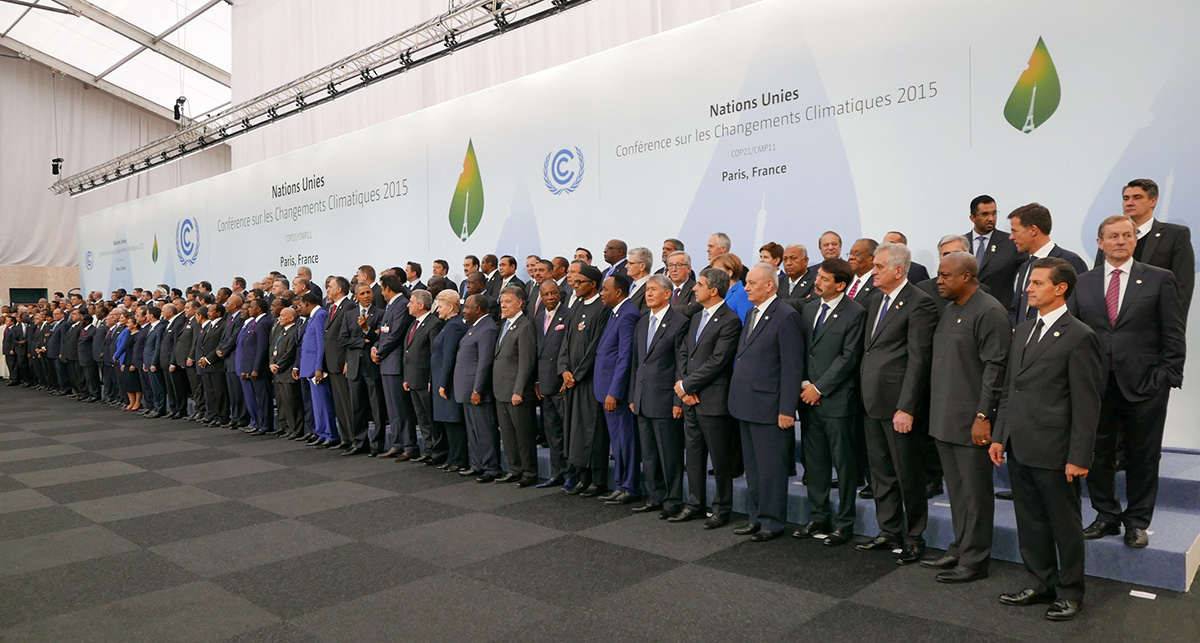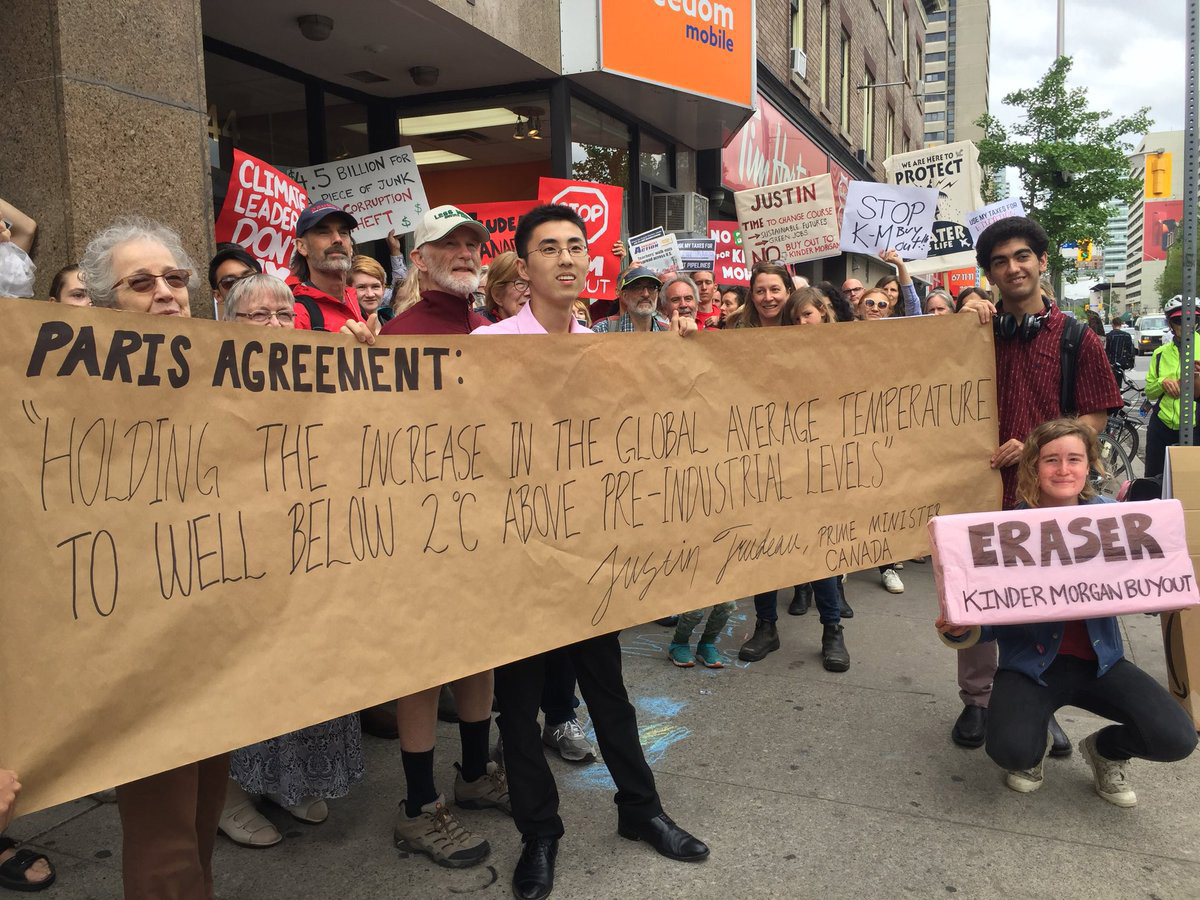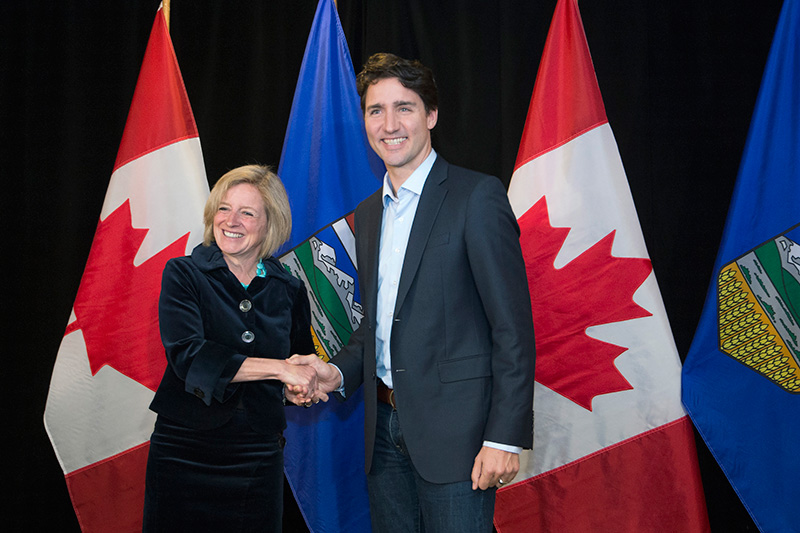“This is the day we step up, at long last, to one of the world’s biggest problems — the pollution that is causing climate change," Alberta Premier Rachel Notley declared on Nov. 22, 2015, as she rolled out a new climate plan for her province. It would phase out coal-fired generators in 15 years, cap oilsands emissions at a level allowing the industry to grow, and impose a carbon tax across Alberta’s economy.
Notley’s announcement came days before Canada’s leaders were to head to Paris to negotiate a new UN global agreement on climate change. When she climbed onto the Telus World of Science stage in Edmonton to unveil her plan, she had some critical information in her back pocket.
That Notley could proceed with confidence had to do with a dinner that occurred in Ottawa just days after Justin Trudeau’s election victory in October. As Vancouver Sun reporter Peter O’Neil revealed, the party comprised three Alberta NDP insiders and an equal number of key figures in the new Trudeau government.
Representing Alberta were Brian Topp, Notley’s chief of staff; Richard Dicerni, head of the Alberta public service; and Andrew Leach, who was then putting the final touches on the climate plan. Sitting on the other side of the table were Trudeau’s top political operatives, Gerry Butts and Katie Telford, along with Privy Council clerk Janice Charette.
After they discussed Alberta’s miserable reputation on the international climate change front, it became clear that Trudeau would back Notley’s carbon tax and “take it national” in short order. And the national carbon tax would give Trudeau licence to approve pipelines that would expand Alberta’s oilsands production. Knowing that Trudeau had her back, Notley could proceed with her plan. The stars were aligning nationally and provincially: Trudeau and Notley could count on each other’s support during the carbon pricing and pipeline approval wars.
It didn’t take long for events to unfold. Two weeks later, John Manley, head of the Canadian Council of Chief Executives, gave Trudeau some advice on how to get serious about climate change. Writing in the online magazine iPolitics, Manley reminded Trudeau that the chief executives had been on record since 2007 about the need to put a price on carbon in order to erase uncertainty for corporate planners and investors.
Manley then made two points: Trudeau had to demonstrate a commitment to “responsible” climate action and he needed to step up efforts to support the export of energy products. More pipelines please. And from the actions Manley said must be undertaken — don’t damage the competitiveness of Canadian companies, phase in carbon pricing gradually, use revenues raised primarily to cut corporate and personal income taxes — it’s clear the responsibility was to the financial well-being of Canadian companies and not to the future of the planet.
And that’s what Trudeau did over the next year, demonstrating a commitment to “responsible” climate action without damaging the corporate bottom line, an agenda also followed by Notley. On the export side of the equation, Trudeau approved two diluted bitumen pipelines plus a liquefied natural gas plant on the British Columbia coast. But he rejected Enbridge’s Northern Gateway pipeline, which by this time was clearly dead to everyone, probably including Enbridge. He also imposed a ban on oil tanker traffic from Quadra Island to north of Prince Rupert, a decision that was necessary to have any hope of moving forward on the national energy strategy.
The day before Trudeau approved the pipelines in November 2016, Manley restated his two points as a “grand bargain”: acquiescing to a price on carbon on one side, building pipelines on the other. Manley reminded all and sundry that the Business Council of Canada had signed on to carbon pricing, so long as it meant getting resources out of the ground and to their customers. “I would be very surprised if there were no pipelines emerging from this,” Manley said at a business forum in Lake Louise, Alberta sponsored by law firm Bennett Jones. “Acquiescence to a price on carbon really is looked at as one side of a grand bargain that would see pipelines built in return.”
The day after Trudeau approved the pipelines, Manley applauded, claiming that approving the pipelines “balances strong environmental protection with responsible energy development.”

There was more to this seeming convergence between CEOs and Trudeau. The Liberal government’s blueprint for a low-carbon future, the “Pan-Canadian Framework on Clean Growth and Climate Change,” was eerily similar to the declaration of Manley’s group nine years earlier, “Clean Growth: Building a Canadian Environmental Superpower.” Aside from a focus on clean growth — a declaration that growth will continue whatever “clean” comes to mean — the parallels in the documents are remarkable.
The chief executives demanded a “coherent national plan of action”; Trudeau delivers a pan-Canadian framework, not quite a national plan, but on the way.
The chief executives asked for investment in new technologies; Trudeau delivers investment in clean technologies.
The chief executives demanded price signals such as emissions trading or carbon tax; Trudeau delivers carbon pricing through either emissions trading or carbon tax.
Pierre vs. Justin
For most of the world, the oil crisis of the 1970s and the signing of the Paris Climate Agreement in 2015 have little in common beyond the fact they both were all about humanity’s seemingly bottomless appetite for burning fossil fuels.
But Canada has an additional commonality: a member of the Trudeau family was leading the country during each of these events.
Prime minister Pierre Trudeau took dramatic action, creating a national energy company and exerting aggressive public oversight of the industry, in the process enraging the big oil companies and their allies in Edmonton and Washington, D.C.
His son, Prime Minister Justin Trudeau, put forward modest measures Big Oil itself had been advocating for a decade, receiving industry’s plaudits.
One Trudeau tried to counter Big Oil’s dominance; the other did Big Oil’s bidding. Pierre Trudeau’s message was this: Canadian oil policy must be for the benefit of Canadians. Justin Trudeau’s message was this: Climate change isn’t a crisis but a market opportunity. We can deal with it by putting a price on carbon and by investing in clean growth.
How did this happen? How did we go from giving the oil industry orders to having the oil industry dictate climate policy?
The answer could be simply that father and son had very different personalities and values. Or it could be that the oil crisis, with its immediate impacts on consumers, workers and investors, required more direct intervention than global warming, a problem that could be pushed off to the future.
But more was at play. When Trudeau the elder created Petro-Canada and introduced the National Energy Program, Keynesianism still reigned supreme. Government intervention in the economy was legitimate. By the time of Trudeau the younger, neoliberalism had transformed economic and political thinking, decreeing that only the market can make decisions.
Neoliberalism reduces the role of government to creating and enforcing markets, and propping them up when they fail, as in the 2008 financial meltdown. Otherwise, just get out of the way.
At first, for decades, Big Oil denied climate change. Then, in a second delaying tactic, it switched to advocating voluntary actions by individual companies and carbon markets. Finally, in 2007, it decided on the way forward. Climate change was real, the industry acknowledged. But instead of being a threat to the bottom line it presented a golden opportunity to develop new markets. These were to be encouraged by establishing modest carbon dioxide emission reduction targets and modest carbon pricing, and promoting growth through government subsidies for clean technologies in a plan that included the approval of new pipelines.
As in each of the previous evasions, the industry had staved off a day of reckoning that would have reduced Canada’s carbon footprint.
Selling ‘opportunities’
By February 2016, the long-awaited national energy strategy was rolling into the station. Trudeau had already adopted the business framing of a transition to a low-carbon economy as an opportunity. In preparation for meetings in Vancouver with provincial and territorial leaders, a press release from Trudeau’s office said the talks “will focus on effective ways to... capitalize on the opportunities presented by a low-carbon economy,” not on what we must do to keep global warming within two degrees Celsius.
In Paris the year before, at the make-or-break climate change meetings, the talk had been all about two degrees Celsius and even 1.5 degrees Celsius, a vastly more ambitious target promoted by Trudeau’s Minister of Environment Catherine McKenna. It was a target Canada had no intention of meeting, as became obvious over the next year.

Canada’s goal was to cut greenhouse gas emissions — its intended nationally determined contribution — 30 per cent below 2005 levels by 2030, reducing emission from 742 megatonnes to 517 megatonnes, admittedly a daunting task (projected as of December 2016). “Canada is back,” Trudeau was telling the assembled dignitaries. Yet while McKenna was setting praiseworthy temperature and emission-reduction targets, she was designing Canada’s escape hatch as well, as chair of the Article 6 committee that authorized emission markets.
McKenna led an informal consultation that put forward proposals presented to the UNFCCC by the International Emissions Trading Association. This is a global organization of oil and gas companies, banks, law firms and consultancies organized by energy giant BP to promote carbon markets during UN negotiations.
Article 6 of the Paris Agreement lays out rules for countries that choose to engage “on a voluntary basis in co-operative approaches that involve the use of internationally transferred mitigation outcomes towards nationally determined contributions.” In plain English, this article authorizes countries to participate in carbon markets as a means of reducing greenhouse gas emissions by buying credits from other countries.
Canada may have taken the lead in this effort because it already knew it could never meet its nationally determined contribution without buying credits from other countries.
Bogged down, bailing out
During 2018, Justin Trudeau faced mounting obstacles to the execution of the “grand bargain” he’d struck with the oil industry: we’ll allow pipeline expansion if you agree to a carbon tax. Trudeau was having difficulty delivering on either side of the equation. Some provinces dragged their heels on any kind of pricing scheme — with the election of Doug Ford, Ontario bailed on the entire concept. Meanwhile, federal opposition parties vowed to kill pricing if they came to power.
At the same time, new pipelines bringing diluted bitumen to the east or west coasts, or even to the U.S., were bogged down in well-funded, highly organized opposition by environmental lobbies and First Nations, threatening oilsands expansion plans.
Unable to deliver, would Trudeau continue to receive oil industry support? His unusual step in the summer of 2018 of bailing out a pipeline that hadn’t even been built was a sign of how far Trudeau’s government would go to support the market. As another federal election loomed, so did the impossibility of squaring a circle. How long could Canadians be persuaded that we could burn more fossil fuel yet not cook the planet?
The article is drawn from The Big Stall: How Big Oil and Think Tanks Are Blocking Action on Climate Change in Canada by Donald Gutstein. Published with permission from Formac Lorimer Books.
You can attend the free, public launch of The Big Stall this Monday, Nov. 19, 7 to 9 p.m. at Spaces, 151 W. Hastings St. in Vancouver. The event will feature author Donald Gutstein, Anjali Appadurai (West Coast Environmental Law), and Shane Gunster (School of Communications, SFU and Corporate Mapping Project Co-investigator). Learn more and register here. ![]()
Read more: Energy, Federal Politics
















Tyee Commenting Guidelines
Comments that violate guidelines risk being deleted, and violations may result in a temporary or permanent user ban. Maintain the spirit of good conversation to stay in the discussion.
*Please note The Tyee is not a forum for spreading misinformation about COVID-19, denying its existence or minimizing its risk to public health.
Do:
Do not: